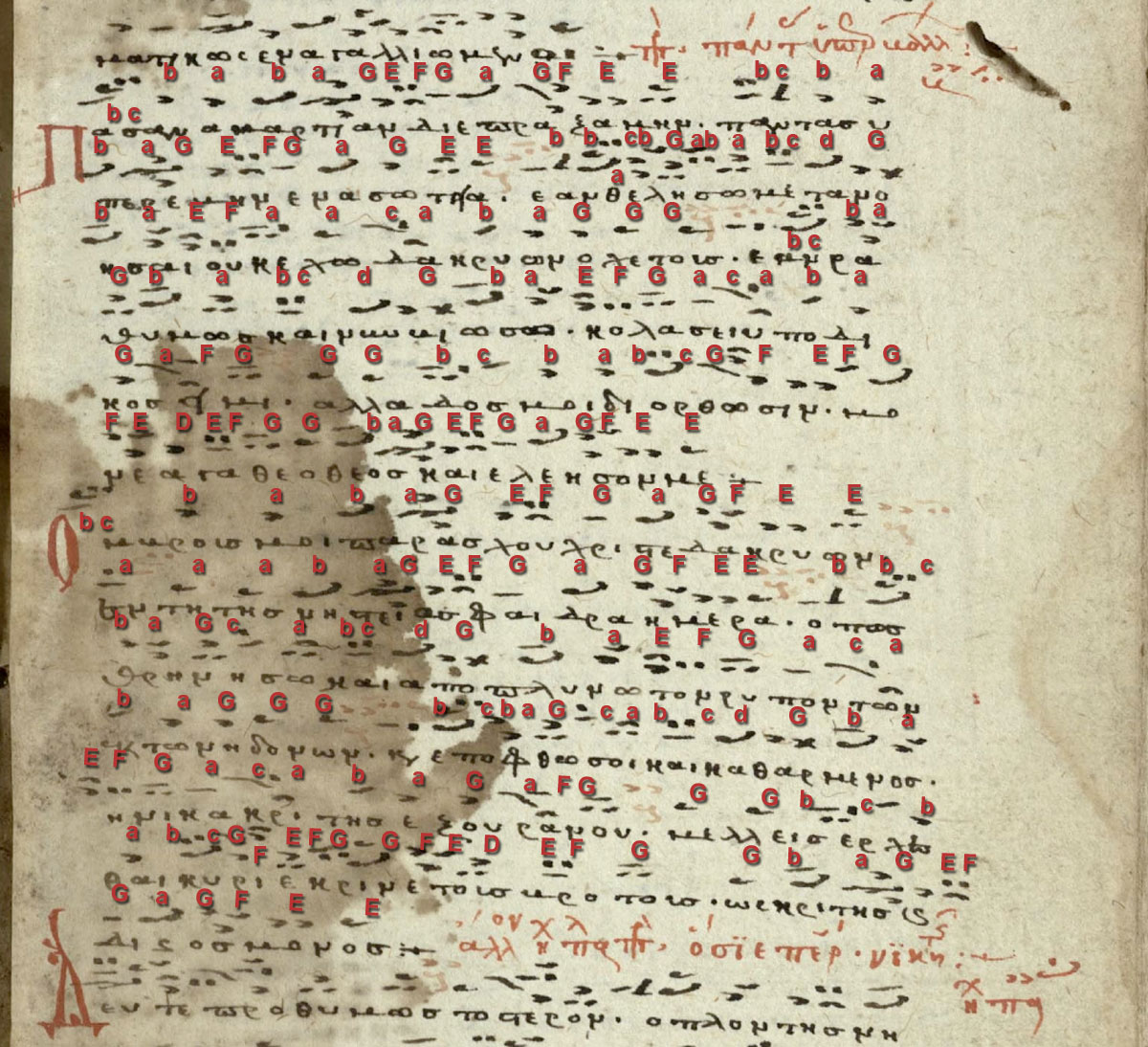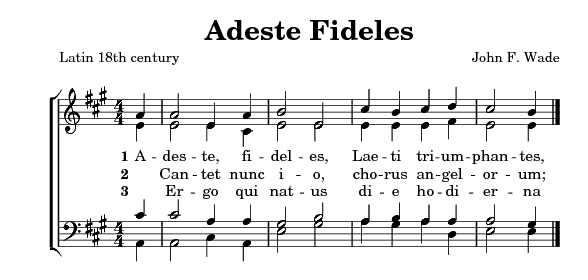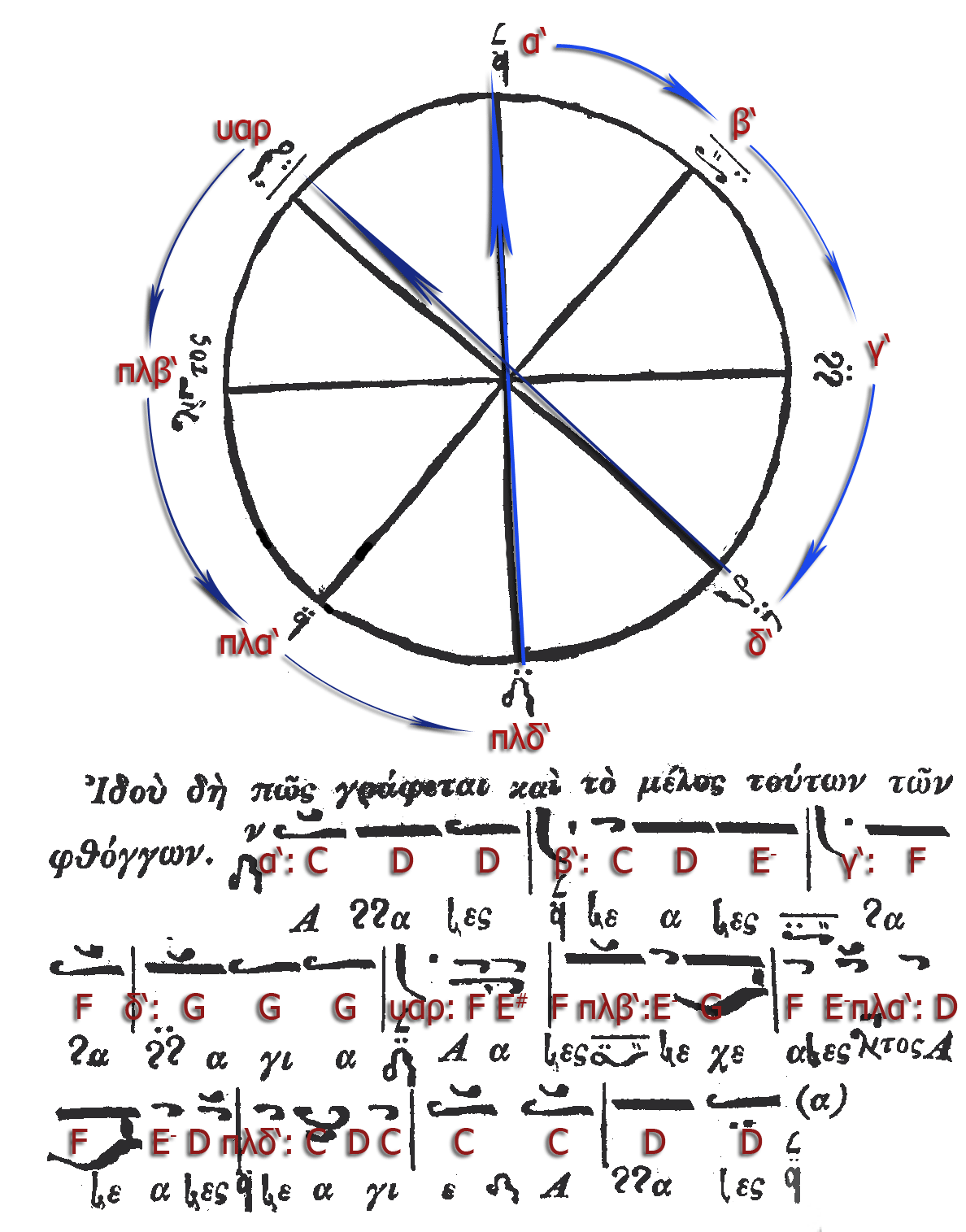|
Octoechos (liturgy)
The Octoechos (from the Greek: ; from ὀκτώ 'eight' and ἦχος 'sound, mode' called echos; cu, Осмѡгласникъ, from о́смь 'eight' and гласъ 'voice, sound') is a liturgical book containing a repertoire of hymns ordered in eight parts according to eight echoi ( tones or modes). Originally created in the Monastery of Stoudios during the 9th century as a hymnal complete with musical notation, it is still used in many rites of Eastern Christianity. The book with similar function in the Western Church is the tonary, and both contain the melodic models of an octoechos system; however, while the tonary serves simply for a modal classification, the octoechos is organized as a cycle of eight weeks of services. The word itself can also refer to the repertoire of hymns sung during the celebrations of the Sunday Office. Role of meter in the Octoechos Many hymns in the Octoechos, such as Kathismata, Odes, and Kontakia are set in a strict meter&mdash ... [...More Info...] [...Related Items...] OR: [Wikipedia] [Google] [Baidu] |
Greek Language
Greek ( el, label= Modern Greek, Ελληνικά, Elliniká, ; grc, Ἑλληνική, Hellēnikḗ) is an independent branch of the Indo-European family of languages, native to Greece, Cyprus, southern Italy (Calabria and Salento), southern Albania, and other regions of the Balkans, the Black Sea coast, Asia Minor, and the Eastern Mediterranean. It has the longest documented history of any Indo-European language, spanning at least 3,400 years of written records. Its writing system is the Greek alphabet, which has been used for approximately 2,800 years; previously, Greek was recorded in writing systems such as Linear B and the Cypriot syllabary. The alphabet arose from the Phoenician script and was in turn the basis of the Latin, Cyrillic, Armenian, Coptic, Gothic, and many other writing systems. The Greek language holds a very important place in the history of the Western world. Beginning with the epics of Homer, ancient Greek literature includes many works of l ... [...More Info...] [...Related Items...] OR: [Wikipedia] [Google] [Baidu] |
Kontakion
The kontakion (Greek , plural , ''kontakia'') is a form of hymn performed in the Orthodox and the Eastern Catholic liturgical traditions. The kontakion originated in the Byzantine Empire around the 6th century and is closely associated with Saint Romanos the Melodist (d. 556). It is divided into strophes (''oikoi'', stanzas) and begins with a prologue (the ''prooimoion'' or ''koukoulion''). A kontakion usually has a biblical theme, and often features dialogue between biblical characters. The only kontakion that is regularly celebrated in full length today is the Akathist to the Theotokos. Etymology The word ''kontakion'' derives from the Greek κόνταξ (''kontax''), which means "rod" or "stick" and refers specifically to the pole around which a scroll is wound. While the genre dates to at least the 6th century, the word itself is attested only in the 9th century. The motivation for the name is likely "the way in which the words on a scroll unfurl as it is read". A hym ... [...More Info...] [...Related Items...] OR: [Wikipedia] [Google] [Baidu] |
Menaion
The Menaion ( el, Μηναῖον; Slavonic: Минїѧ, ''Miniya'', "of the month") is the liturgical book used by the Eastern Orthodox Churchand those Eastern Catholic Churches which follow the Byzantine Rite containing the propers for fixed dates of the calendar year, ''i.e.'' entities not dependent of the date of Easter. The Menaion is the largest volume of the propers for the Byzantine Rite and is used at nearly all the daily services. Editions The complete Menaion is published in twelve volumes, one for each month; the first volume is for September which commences the Byzantine liturgical year. The Festal Menaion is an abridged version containing texts for those great feasts falling on the fixed cycle, some editions also containing feasts of the major saints. The General Menaion contains services for each type of celebration (apostles, martyrs, etc.) with blank spaces for the name of the saint(s) commemorated. Originating before the invention of printing when t ... [...More Info...] [...Related Items...] OR: [Wikipedia] [Google] [Baidu] |
Musical Notation
Music notation or musical notation is any system used to visually represent aurally perceived music played with instruments or sung by the human voice through the use of written, printed, or otherwise-produced symbols, including notation for durations of absence of sound such as rests. The types and methods of notation have varied between cultures and throughout history, and much information about ancient music notation is fragmentary. Even in the same time period, such as in the 2010s, different styles of music and different cultures use different music notation methods; for example, for professional classical music performers, sheet music using staves and noteheads is the most common way of notating music, but for professional country music session musicians, the Nashville Number System is the main method. The symbols used include ancient symbols and modern symbols made upon any media such as symbols cut into stone, made in clay tablets, made using a pen on papyrus ... [...More Info...] [...Related Items...] OR: [Wikipedia] [Google] [Baidu] |
Idiomelon
(Medieval Greek: from , 'unique' and , 'melody'; Church Slavonic: , )—pl. ''idiomela''—is a type of sticheron found in the liturgical books used in the Eastern Orthodox Church, the Eastern Catholic Churches which follow the Byzantine Rite, and many other Orthodox communities like Old Believers. are unique compositions, while or —sing. , or (Medieval Greek: , Church Slavonic: , )—were used to create other hymns by a composition over the 's melody and following the poetic meter provided by the musical rhythm. The genre composed over these was characterised as or (Medieval Greek: 'similar to', Church Slavonic: , ). Definition of ''idiomelon'', ''avtomelon'' and ''prosomoion'' The hymn category can only be understood in comparison with and . Already in the older book Tropologion each melody of a certain hymn was classified by a modal signature of the Byzantine octoechos—the eight-mode system as it had developed in Constantinople, Damascus, Jerusalem, and in ... [...More Info...] [...Related Items...] OR: [Wikipedia] [Google] [Baidu] |
Valaam Monastery
The Valaam Monastery (russian: Валаамский монастырь; Finnish version: ''Valamo Monastery'') is a stauropegic Orthodox monastery in Russian Karelia, located on Valaam, the largest island in Lake Ladoga, the largest lake in Europe. History It is not clear when the monastery was founded, as the cloister is not mentioned in documents before the 16th century. Dates from the 10th to the 15th centuries having been suggested. According to one tradition, the monastery was founded by a 10th-century Greek monk, Sergius of Valaam, and his Karelian companion, Herman of Valaam. Heikki Kirkinen inclines to date the foundation of the monastery to the 12th century. Contemporary historians consider even this date too early. According to the scholarly consensus, the monastery was founded at some point towards the end of the 14th century. John H. Lind and Michael C. Paul date the founding to between 1389 and 1393 based on various sources, including the "Tale of the Valaamo Mo ... [...More Info...] [...Related Items...] OR: [Wikipedia] [Google] [Baidu] |
YouTube
YouTube is a global online video sharing and social media platform headquartered in San Bruno, California. It was launched on February 14, 2005, by Steve Chen, Chad Hurley, and Jawed Karim. It is owned by Google, and is the second most visited website, after Google Search. YouTube has more than 2.5 billion monthly users who collectively watch more than one billion hours of videos each day. , videos were being uploaded at a rate of more than 500 hours of content per minute. In October 2006, YouTube was bought by Google for $1.65 billion. Google's ownership of YouTube expanded the site's business model, expanding from generating revenue from advertisements alone, to offering paid content such as movies and exclusive content produced by YouTube. It also offers YouTube Premium, a paid subscription option for watching content without ads. YouTube also approved creators to participate in Google's AdSense program, which seeks to generate more revenue for both parties. ... [...More Info...] [...Related Items...] OR: [Wikipedia] [Google] [Baidu] |
Automelon
(Medieval Greek: from , 'unique' and , 'melody'; Church Slavonic: , )—pl. ''idiomela''—is a type of sticheron found in the liturgical books used in the Eastern Orthodox Church, the Eastern Catholic Churches which follow the Byzantine Rite, and many other Orthodox communities like Old Believers. are unique compositions, while or —sing. , or (Medieval Greek: , Church Slavonic: , )—were used to create other hymns by a composition over the 's melody and following the poetic meter provided by the musical rhythm. The genre composed over these was characterised as or (Medieval Greek: 'similar to', Church Slavonic: , ). Definition of ''idiomelon'', ''avtomelon'' and ''prosomoion'' The hymn category can only be understood in comparison with and . Already in the older book Tropologion each melody of a certain hymn was classified by a modal signature of the Byzantine octoechos—the eight-mode system as it had developed in Constantinople, Damascus, Jerusalem, and in ... [...More Info...] [...Related Items...] OR: [Wikipedia] [Google] [Baidu] |
Hymn Tune
A hymn tune is the melody of a musical composition to which a hymn text is sung. Musically speaking, a hymn is generally understood to have four-part (or more) harmony, a fast harmonic rhythm (chords change frequently), with or without refrain or chorus. From the late sixteenth century in England and Scotland, when most people were not musically literate and learned melodies by rote, it was a common practice to sing a new text to a hymn tune the singers already knew which had a suitable meter and character. There are many hymn tunes which might fit a particular hymn: a hymn in Long Metre might be sung to any hymn tune in Long Metre, but the tunes might be as different as those tunes that have been used for centuries with hymns such as '' Te lucis ante terminum'', on one hand, and an arrangement of the calypso tune used with ''Jamaica Farewell'', on the other. Hymnal editors Editors bring extensive knowledge of theology, poetry, and music to the process of compiling a new ... [...More Info...] [...Related Items...] OR: [Wikipedia] [Google] [Baidu] |
Neobyzantine Octoechos
Oktōēchos (here transcribed "Octoechos"; Greek: ; from ὀκτώ "eight" and ἦχος "sound, mode" called echos; Slavonic: Осмогласие, ''Osmoglasie'' from о́смь "eight" and гласъ "voice, sound") is the name of the eight mode system used for the composition of religious chant in Byzantine, Syriac, Armenian, Georgian, Latin and Slavic churches since the Middle Ages. In a modified form the octoechos is still regarded as the foundation of the tradition of monodic Orthodox chant today. From a Phanariot point of view, the re-formulation of the Octoechos and its melodic models according to the New Method was neither a simplification of the Byzantine tradition nor an adaption to Western tonality and its method of an heptaphonic solfeggio, just based on one tone system (σύστημα κατὰ ἑπταφωνίαν). Quite the opposite, as a universal approach to music traditions of the Mediterranean it was rather based on the integrative power of the psa ... [...More Info...] [...Related Items...] OR: [Wikipedia] [Google] [Baidu] |






.jpg)


